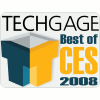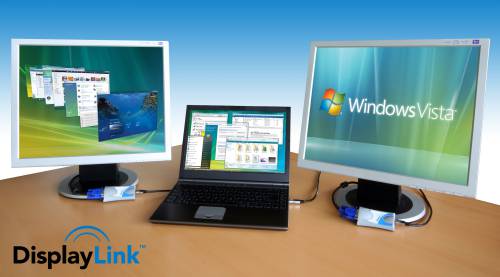- Qualcomm Launches Snapdragon 4 Gen 2 Mobile Platform
- AMD Launches Ryzen PRO 7000 Series Mobile & Desktop Platform
- Intel Launches Sleek Single-Slot Arc Pro A60 Workstation Graphics Card
- NVIDIA Announces Latest Ada Lovelace Additions: GeForce RTX 4060 Ti & RTX 4060
- Maxon Redshift With AMD Radeon GPU Rendering Support Now Available
Best of CES 2008

We saw numerous products and technologies at CES earlier this month, but only ten of those deserved our “Best of” award. Included inside is Gateway’s latest gaming notebook, Logitech’s Squeezebox Duet, CoolIT’s dual-GPU cooler, DisplayLink’s USB display tech and more.
Page 3 – Rob: DisplayLink Multi-Monitor Technology
|
|
DisplayLink Technology
DisplayLink is a newer company that began growing in popularity last year thanks to the Samsung Syncmaster 940UX monitor, which was the first on the market to offer a USB interface, in addition to the usual VGA and DVI options. The goal of that monitor was simple… to have the ability to be added to any Windows machine on the market, as long as there was an open USB port somewhere.
The idea, at first, seems a little ridiculous. “Why not just install a second graphics card?” is a common question, but it boils down to two things. First and foremost, this solution is supposed to be simple to execute for anyone, not just techies. The other thing is that this solution is geared towards those who want to hook up to six monitors off of a single machine. It’s difficult to get that done with a few video cards.
DisplayLink doesn’t sell products to the end-user, but rather sells their chips to other companies to produce a fine-looking product for purchase. IOGear, Kensington and eVGA are the three companies I noticed at the show that all had similar products utilizing DisplayLink’s technology. Pricing for these products are not exactly that inexpensive, at around $100, but to many, it will still beat installing a second graphics card. For those who want many monitors, DisplayLink might be the lone solution available.

Installation is a relative breeze, even for a novice. Depending on the solution you have, installation will vary, but the typical method is plugging in a USB cable to your machine and run it to the DisplayLink-enabled product, and then running the video cable from that box to the monitor you wish to use. After installing the appropriate software, the other screen should light up and be usable right away, or at least after a quick reboot.
As mentioned already, DisplayLink supports much more than a two or even three monitor setup. Depending on the workload, the technology supports up to six monitors, all which would be run at a modest resolution, such as 1280×1024, although 1600×1200 is supported. When throwing a slew of monitors into the pile, however, bandwidth might become a concern.
As far as gaming is concerned, it is a possibility, but DisplayLink notes that newer games may run into problems given the amount of video bandwidth they require. The USB connection on your machine will top out at a certain point, so 1080p video (an unlikely scenario) might stutter. I personally tested out 720p playback and had no issues, however. Though pricey, DisplayLink’s technologies will help open doors for many people who want to add a second monitor to their setup, without much hassle.
|
|
Support our efforts! With ad revenue at an all-time low for written websites, we're relying more than ever on reader support to help us continue putting so much effort into this type of content. You can support us by becoming a Patron, or by using our Amazon shopping affiliate links listed through our articles. Thanks for your support!




